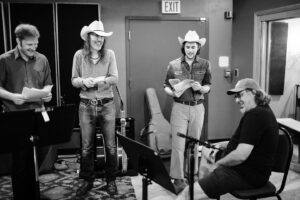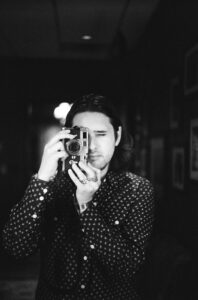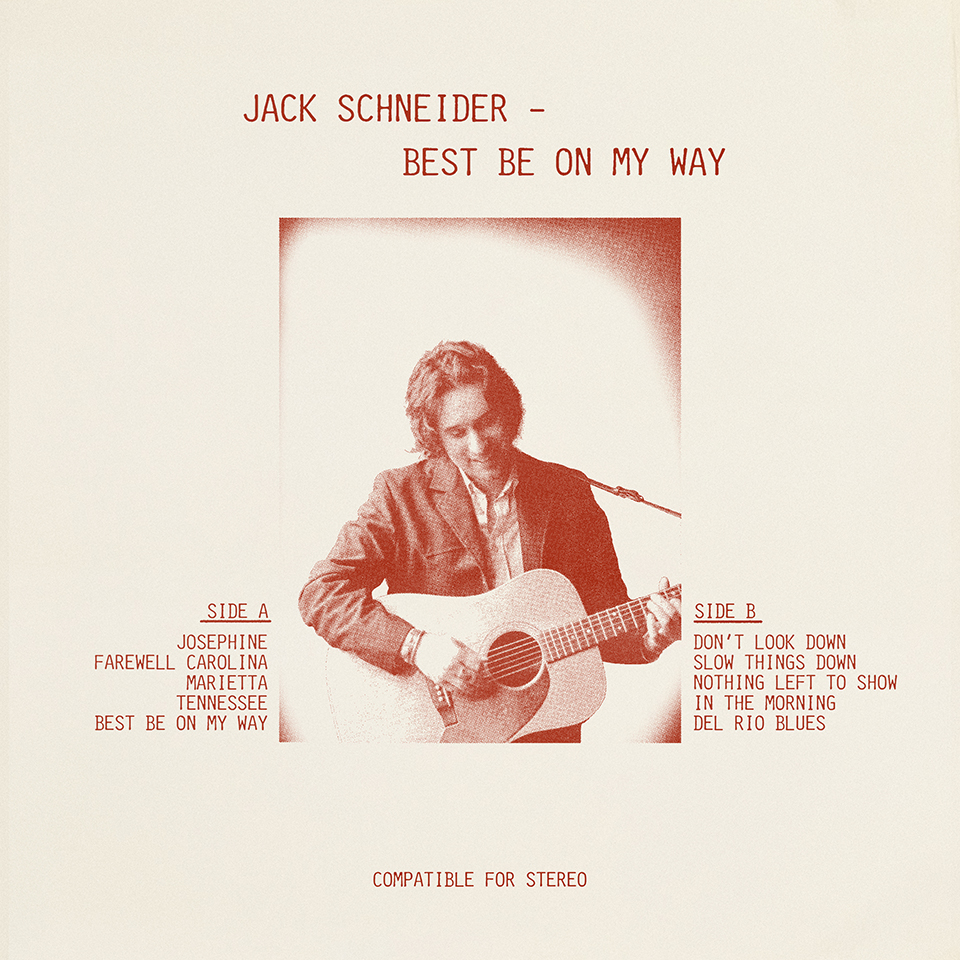The simplicity of the songs that found their way to Jack Schneider’s debut album Best Be on My Way may be deceptive. The factors that brought Schneider to this point in his music career have been years in the making. He admits his first advantage was having parents in the art world. His mother a painter and gallery curator in New York, and his father was an architect. While they loved the culture and art community of the city, they decided to move somewhere more conducive to raising a family when Jack was born.
They moved to Atlanta when he was two, but, he says, “We visited New York a lot. My parents still wanted New York to be a part of my cognitive brainwork.” He returned for college, attending NYU, where he started to understand why the city was so important to his parents. While he focused his studies on music, he continued to incorporate all the arts in the process of becoming a creative individual, regularly visiting art museums there.
“Living in New York City was a connection to my parents,” he said, “but it was also important in connecting dots about what art is and how art functions in society. In many ways, those experiences influenced the way I use music as a vehicle to make art. Playing guitar, I don’t have the music theory background that a lot of musicians have. My background is visual art and understanding art history and thinking about how this instrument I’m playing can embody some of the qualities of visual art texture– color shape and contour. I’ve applied a lot of those concepts to the way that I play guitar.”
He first became interested in the guitar at three when he came across the instrument his mother had bought when moving to Atlanta, hoping to learn to serenade her son. Eventually, the guitar was sitting unused when Jack was drawn to it.
When his mother saw him trying to play the guitar like a cello, she called Maple Street Guitars and got Charles Williams on the phone.
She told Williams, “I want to get lessons for my three-year-old. Don’t hang up!” He didn’t. Williams went on to become Schneider’s lifelong friend and mentor.
What followed, said Schneider, was not the usual guitar lessons. “We were not learning how to play guitar. I don’t think he taught me how to play chords or how to identify notes. Instead, he instilled a passion for the instrument in me and encourage me to just play.” No one had to make him practice.
“It wasn’t about learning music theory but about understanding the power of holding this box in your hand, this string and wood. and realizing that I can do so much with that,” Schneider said. “I learned I could create all sorts of sounds and styles and colors and then collaborate and connect with other people through that vehicle. My relationship with Charles was one of the most emotionally rewarding relationships of my life because of what he instilled in me–the passion of music.”
Schneider says he continued to choose a path that let him pursue music in order to “create something through the lens of how it makes you feel, as opposed to the technicalities behind how chord structures work and how musical notation works.” While he understands the purpose for music theory, he says, “for me, in my relationship with guitar as a vehicle for visual art, not having been forced to go down that path at the wrong moment preserved in me the natural passion for just picking an instrument up and wanting to play it.”
Along the way, Schneider continued to seek mentors who spoke into his developing creativity in profound ways. For example, his middle school teacher instilled the importance of being able to answer, “So what?” when writing. “There has to be intention; there has to be purpose,” he said, “and I’ve learned a lot of lessons in relation to music that did not necessarily come from studying music. Studying English, visual art, and art history shaped my understanding a lot, but the ‘So what?’ stuck. When I’m going to make something to present to people, I want to answer why? So what? Why, as a 25-year-old, should I expect people to care?”
He also credits a cassette tape An Evening with John Denver with sparking his musical interest. His father shared it, a gift from his own grandmother he had kept into adulthood. “For some reason,” says Schneider, “it resonated with me.” His first mentor after Williams was
Steve Weisberg, whom he tracked down on the internet when he was fourteen. Weisberg had played guitar on Denver’s album, and Schneider thought he too might have something to teach him.
. “I got to a point then where I wanted to talk about what it means to be an accompanist, to play guitar for other people instead myself, so I got in touch with him.” Even though Weisberg lived in Texas, they talked by phone weekly. Weisberg gave him insight, including the mantra he shared that has stuck with Schneider: “The main thing is to keep the main thing the main thing.”
The two met in person only once, in the airport, on December 31, 2012, the anniversary of Denver’s birth, when Weisberg had a layover for a few hours, and they played music together. Weisberg was diagnosed with cancer shortly after, and Schneider considers his death one of his first bouts with loss.
“I saw the fragility of existence for the first time,” he said, “and it really instilled in me the importance of mentors and in connecting with people who’ve learned the lessons that I haven’t learned yet.”
Schneider’s recognition of the value of mentorship didn’t stop with Williams and Weisberg. In high school, he explained, he felt he had hit a wall in playing the guitar.
“I knew I wanted to use the guitar to make sounds have color or depth or texture, the same parameters that I would use to evaluate visual art. If I wanted to look at the contour of lines or to think specifically in the context of the songs that I was writing, then I was using a lot of open tunings. With the instruments I’ve been around, I was hearing more of the strain and less of the shape of sound that I loved on records.”
He realized what he was playing did not line up with the sound he believed possible. He listened to favorite records and heard so much sense of depth in the recording, especially young Bob Dylan.
“It was just him and an acoustic guitar, and even though he’s just strumming, there’s nothing overly complicated about the way he’s playing guitar, but I could listen to it and hear a sense of depth, a sense of urgency, and a sense of sharpness, a sense of softness–so many little nuances in the sound of this instrument.”
He realized he needed to learn more about the instruments themselves if he wanted to create sounds he heard in his head. As he researched, one name kept popping up—George Gruhn of Gruhn Guitars. He read every article and watched every video he could find about the man.
Schneider says he thought, “Wow! This person understands instruments more than anyone I’ve ever known. He’s smart at connecting dots from instruments to other aspects of creativity or career or society. He’s looking at things bigger picture than just instruments. This is somebody I would really love to talk to.”
At 15, he convinced my parents to drive him to Nashville from Atlanta to meet Gruhn. He spent three full days that weekend with him, asking questions and learning from the man. The pair stayed in touch via email, so when Schneider was studying at NYU and needed a job, he called Gruhn. He told him, “I only have three months to offer, but I would love to learn and work.” Gruhn put him on a special project that summer, archiving a guitar collection that had belonged to the late Steve Shaw, the son of composer Artie Shaw. He had named Gruhn executor of his estate with the charge of turning the collection into a museum (now on display at Belmont University). Gruhn had Schneider to go through the collection, taking pictures of every instrument and writing out notes about their condition.
“Some of them needed extensive repair work, but that collection had 470 instruments–really collectible one-of-a-kind instruments, and here I was, an 18-year-old kid with marginal knowledge of instruments, but not what George had. I got to handle each one, spend time with them, play them, and develop my sense of listening, in addition to the knowledge of the instruments and how they function, the specifics about different woods and different materials.”
He enjoyed the work so much that he returned the next summer and continued to learn. While working at Gruhn Guitar, he also met Wes Langlois. The two hit it off, he said, because they saw art similarly and played guitar similarly.
After graduating, Jack moved to Nashville, and he and Langlois started collaborating. During the pandemic, Schneider found himself stuck at home with no opportunity to perform or to collaborate. He and Langlois started writing and recording songs for fun at home—eventually completing about 150 songs.
“We’d spend days just playing songs that we loved, and other days something would show up, we’d put some words to it, and next thing we know, we have written two or three songs in an afternoon,” he said. During that time, they came up with the idea for the “vanishing albums,” Fields of Surrender and Cactus Land.
“The original idea was to make them available in physical copy, but to make only ten copies of each record. When they sold out, they were done and nobody could hear them again,” said Schneider. They decided instead to make the music available digitally for only a week.
“I see art as sometimes fleeting,” he said. “It’s more precious when you know it’s going away. It’s how I think about live shows: It’s a real moment, and when it’s over, it’s over. You can’t go back.”
While the albums themselves were short-lived, some of the songs survived to appear on Best Be on My Way, Schneider’s first tangible full-length album. “Josephine” and “Don’t Look Down,” two singles released in advanced of the album were new; others, such as “Farewell Carolina” and “Del Rio Blues” had appeared on the vanishing albums.
While Schneider’s name appears on the project as the lead singer, he considers his partnership with Langlois as “more of a very small band.” The two have opened for Gordon Lightfoot and for Ricky Skaggs, as well as playing together as a duo.
Schneider chooses to record all his music analog on tape, including the new album, he says, “not just because of the sound, but also because of the process. In that decisive moment when that red light is on and what you’re playing is being put on tape, you can’t go and edit, tune your voice, or cut it up and put it together. You’ve got to have everybody in the room, and you’re capturing something real. That’s the decisive moment.”
The connection with mentors also opened some doors when Schneider started planning for Best Be on My Way. Gruhn had introduced him to Vince Gill, telling him, “You remind me a lot of somebody I met when he was your age.” While he admits that Gill is kind to everyone, the two found they had similarities. One evening, Gill opened the doors for Schneider to join him, his wife Amy Grant, and songwriter Don Schlitz at the Bluebird Café. Vince went on to sing harmony with him on “Remember the Dance,” the song he performed that night, and to have him sing it on the Opry. Gill also gave Schneider the opportunity to play guitar in his band and on tour, also working as guitar tech.

When the time came to line up musicians for the album, Schneider and Langlois considered their dream team. They asked Dennis Crouch to play bass, Stuart Duncan to play fiddle, and both agreed. Vince Gill was next to say yes, and then they asked David Rawlings to play guitar. Joining these veteran studio musicians were Liv Greene, a longtime friend of Schneider, and Griffin Photoglou, both musicians, like Schneider, in their twenties.
“Next thing we know,” said Schneider, “we’re in a room with all these people, the tape is rolling, and we just played the songs. We let the moment guide the songs more than the songs guide informing the moment.”
Jack Schneider has been called a “triple threat”: guitarist, singer, and songwriter. While singer-songwriter doesn’t always convey vocal talent, his sound has been compared to musicians known for their voices. He considers his singing style his own invention but with a nod to John Denver and to Bob Dylan “from back when he was more of a vocalist.” He says he thinks of himself more as a band member in his own band than as a singer.
“I can’t sing show tunes, and I can’t sing like Vince, but I can do something with my voice unique to my personality that embodies the spirit of my music, so whether or not it’s the right way to sing, it’s my way,” he explained. And he keeps it simple, wanting the song to come across more than the music.
“If I can pull back and have fewer things going on, that’s usually going to bring more out of the song. It’s about keeping things small. I didn’t want to add a ton of instruments; four people was enough. That accomplished what we set out to accomplish, and it was a moment in time in which I got to sit around and play songs with my heroes.”
He added, “I wanted to capture that moment in my life. That’s why in some ways this record is a black-and-white photograph. It’s this a day in my life and in time, a day that shaped who I wanted to be and who I believed I could be, and it just it happened. In the blink of an eye, the day was over, but I’m so glad that there is that black and white photograph to hold on to.”

http://www.jackschneidermusic.com

